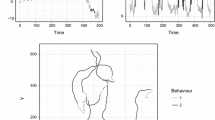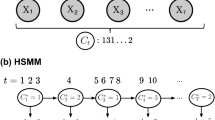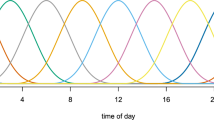Abstract
Hourly pedometer counts and irregularly measured concentration of the hormone progesterone were available for a large number of dairy cattle. A hidden semi-Markov was applied to this bivariate time-series data for the purposes of monitoring the reproductive status of cattle. In particular, the ability to identify oestrus is investigated as this is of great importance to farm management. Progesterone concentration is a more accurate but more expensive method than pedometer counts, and we evaluate the added benefits of a model that includes this variable. The resulting model is biologically sensible, but validation is difficult. We utilize some auxiliary data to demonstrate the model’s performance.
Similar content being viewed by others
References
Ball, P. J. H., and Peters, A. R. (2004), Reproduction in Cattle (3rd ed.), Oxford: Blackwell Publishing.
Baum, L., Petrie, T., Soules, G., and Weiss, N. (1970), “A Maximization Technique Occurring in the Statistical Analysis of Probabilistic Functions of Markov Chains,” The Annals of Mathematical Statistics, 41, 164–171.
Choi, S., and Wette, R. (1969), “Maximum Likelihood Estimation of the Parameters of the Gamma Distribution and Their Bias,” Technometrics, 11, 683–690.
Dempster, A., Laird, N., and Rubin, D. (1977), “Maximum Likelihood from Incomplete Data Via the EM Algorithm,” Journal of the Royal Statistical Society. Series B (Methodological), 39, 1–38.
Ferguson, J. (1980), Hidden Markov Analysis: An Introduction, Hidden Markov Models for Speech.
Firk, R., Stamer, E., Junge, W., and Krieter, J. (2002), “Automation of Oestrus Detection in Dairy Cows: A Review,” Livestock Production Science, 75, 219–232.
Forney, G. Jr. (1973), “The Viterbi Algorithm,” Proceedings of the IEEE, 61, 268–278.
Friggens, N. C., and Løvendahl, P. (2008), “The Potential of On-Farm Fertility Profiles: In-Line Progesterone and Activity Measurements,” in Fertility in Dairy Cows: Bridging the Gaps, British Society of Animal Science, eds. N. C. Friggens, M. D. Royal, R. Smith, Cambridge University Press, Cambridge, pp. 72–78.
Friggens, N. C., Bjerring, M., Ridder, C., Højsgaard, S., and Larsen, T. (2008), “Improved Detection of Reproductive Status in Dairy Cows Using Milk Progesterone Measurements,” Reproduction in Domestic Animals, 43, 113–121.
Guédon, Y. (2003), “Estimating Hidden Semi-Markov Chains From Discrete Sequences,” Journal of Computational & Graphical Statistics, 12, 604–639.
Holt, C. (1957), “Forecasting Trends and Seasonals by Exponentially Weighted Moving Averages,” ONR Memorandum, 52.
Hughes, J., Guttorp, P., and Charles, S. (1999), “A Non-Homogeneous Hidden Markov Model for Precipitation Occurrence,” Journal of the Royal Statistical Society (Series C): Applied Statistics, 48, 15–30.
Jonsson, R., Bjorgvinsson, T., Blanke, M., Poulsen, N., Højsgaard, S., and Munksgaard, L. (2008), “Oestrus Detection in Dairy Cows Using Likelihood Ratio Tests,” The International Federation of Automatic Control, 658–663.
Krogh, A., Mian, I., and Haussler, D. (1994), “A Hidden Markov Model that Finds Genes in E. Coli DNA,” Nucleic Acids Research, 22, 4768–4778.
Meyer, D. (2002), “Naive Time Series Forecasting Methods,” R News, 2, 7–10.
O’Connell, J., and Højsgaard, S. (2009a, submitted), “Hidden Semi Markov Models for Multiple Observation Sequences—The MHSMM Package for R,” Journal of Statistical Software.
O’Connell, J., and Højsgaard, S. (2009b), “MHSMM: Parameter Estimation and Prediction for Hidden Markov and Semi-Markov Models for Data with Multiple Observation Sequences,” http://cran.r-project.org/web/packages/mhsmm/index.html. R package version 0.3.0.
R Development Core Team (2008), R: A Language and Environment for Statistical Computing, Vienna: R Foundation for Statistical Computing. ISBN 3-900051-07-0.
Rabiner, L. (1989), “A Tutorial on Hidden Markov Models and Selected Applications in Speech Recognition,” Proceedings of the IEEE, 77, 257–286.
Roelofs, J., van Eerdenburg, F., Soede, N., and Kemp, B. (2005), “Various Behavioral Signs of Estrous and their Relationship with Time of Ovulation in Dairy Cattle,” Theriogenology, 63, 1366–1377.
Sansom, J., and Thomson, P. (2001), “Fitting Hidden Semi–Markov Models to Breakpoint Rainfall Data,” Journal of Applied Probability, 38, 142–157.
Winter, P. (1959), “Forecasting Sales by Exponentially Weighted Moving Averages,” Management Science, 6, 324–342.
Author information
Authors and Affiliations
Corresponding author
Rights and permissions
About this article
Cite this article
O’Connell, J., Tøgersen, F.A., Friggens, N.C. et al. Combining Cattle Activity and Progesterone Measurements Using Hidden Semi-Markov Models. JABES 16, 1–16 (2011). https://doi.org/10.1007/s13253-010-0033-7
Accepted:
Published:
Issue Date:
DOI: https://doi.org/10.1007/s13253-010-0033-7




